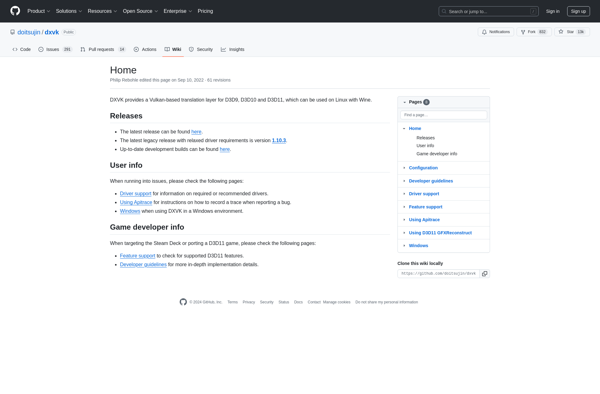Direct3D 9-to-11 (Series)

Direct3D 9-to-11: Bridge Between Legacy and Modern Graphics
Direct3D 9-to-11 is a middleware tool that allows games and applications using the legacy Direct3D 9 graphics API to take advantage of newer Direct3D 11 GPU hardware features. It acts as a translation layer between the old API and the new one.
What is Direct3D 9-to-11 (Series)?
Direct3D 9-to-11 (also known as D3D9on12 or D3D9on11) is a middleware software solution developed by Microsoft that aims to ease the transition from the older Direct3D 9 graphics API to the newer Direct3D 11 API. It works by acting as a translation layer, allowing games and applications that were originally written against Direct3D 9 to take advantage of modern Direct3D 11 compliant GPU hardware features and improvements.
The key benefit of Direct3D 9-to-11 is that it can provide substantial performance improvements and access to new graphics features without requiring developers to do a full port or rewrite of their Direct3D 9 codebase. This makes it an attractive option for breathing new life into older games and apps. The middleware handles the translation from Direct3D 9 calls into equivalent Direct3D 11 calls behind the scenes.
Some of the enhanced GPU features it can unlock include improved antialiasing, higher resolution shadow maps, texture filtering, tessellation, multi-threading, and reduced CPU bottlenecking. Support varies across hardware vendors and device generations. Overall it enables legacy D3D9 content to achieve faster frame rates and better graphics quality on D3D11-class hardware.
Direct3D 9-to-11 is designed to be non-destructive and introduce minimal overhead. Developers can ship an app using both Direct3D 9 and Direct3D 9-to-11 render paths to maximize compatibility and performance across different machines. It’s offered as both an OS-level component in Windows 8+ and as a redistributable runtime package for Windows 7 or earlier OSes. It requires the DirectX 11 runtime and a Direct3D 11.1 compatible GPU to function.
Direct3D 9-to-11 (Series) Features
Features
- Allows legacy Direct3D 9 applications to use newer Direct3D 11 GPU features
- Provides a translation layer between Direct3D 9 and Direct3D 11 APIs
- Supports newer graphics effects like tessellation, compute shaders without code changes
- Automatic conversion of shader models from 9 to 11
- Can improve performance of older games/apps when running on newer hardware
Pricing
- Free
- Open Source
Pros
Cons
Official Links
Reviews & Ratings
Login to ReviewNo reviews yet
Be the first to share your experience with Direct3D 9-to-11 (Series)!
Login to ReviewThe Best Direct3D 9-to-11 (Series) Alternatives
Top Gaming Software and Graphics Apis and other similar apps like Direct3D 9-to-11 (Series)
Here are some alternatives to Direct3D 9-to-11 (Series):
Suggest an alternative ❐WineD3D

DXVK

DXUP

D9VK
